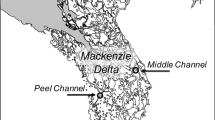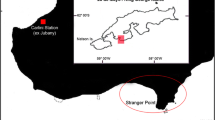Abstract
The diet of Mediterranean Gull chicks was investigated in a Macedonian wetland using three different sampling methods: stomachs from freshly dead chicks (1988), regurgitations (1987) and carcass stomachs (1986–88). In fresh stomachs, gastropods were the most important animal prey by mass and insects by numbers. In terms of overall volume and biomass, wheat grains were the most important food. In regurgitations and carcass stomachs insects were the most important prey. Comparison of the results from the different methods revealed considerable differences which are attributed to feeding behaviour of the gulls and prey dynamics rather than the methodology used. The importance of prey types is discussed; composition of diet probably differs considerably between geographical areas
Zusammenfassung
In einem Feuchtgebiet Mazedoniens wurde die Nahrung junger Schwarzkopfmöwen nach drei verschiedenen Methoden untersucht: Magenanalysen frischtoter Küken (1988), ausgewürgte Nahrungsbestandteile (1987) and Mageninhalte toter Jungvögel (1986–88). In frischen Mageninhalten machten der Masse nach Gastropoden, der Zahl nach Insekten die wichtigsten Nahrungsanteile aus. In allen Proben bildeten in Volumen und Biomasse Weizenkörner die wichtigste Nahrung, in ausgewürgten Proben und Mageninhalten toter Vögel Insekten. Der Vergleich der nach unterschiedlichen Methoden gewonnenen Ergebnisse ergab bemerkenswerte Unterschiede der Zahlenververhältnisse, doch nur gelegentliche Unterschiede in den Anteilen der wichtigsten Nahrungsbestandteile. Solche Unterschiede sind hauptsächlich auf das Verhalten der Möwen bei der Nahrunungssuche und auf die Dynamik des Beuteangebots zurückzuführen, weniger auf die Methodik der Probengewinnung. Erhebliche geographische Unterschiede in der Ernährung der Küken scheinen zu bestehen.
Similar content being viewed by others
Literature
Ardamatskaya, T. B., V. I. Vakarenko &A. A. Petrusenko (1988): Feeding ecology of Mediterranean Gulls (Larus melanocephalus) during the breeding season in the Black Sea Nature Reserve. In:V. D. Ilyichev, Bird ecology and behaviour. Tr. Vsesoyuz. Orn. Obshch. 2: 76–88. Moscow.
Ardemagni, A., C. Cantoni, P. Cattaneo &D. Grieco (1977): Alcuni aspetti della composizione chimica delle chioccide. Atti convegne sulla chiocciola (Helix pomatia) Symposium. Quaderno Io Centro di Elicicoltura 6: 33–38.
Cramp, S., &K. E. L. Simmons (1983): The birds of the Western Palearctic. Vol. III. Oxford.
Duffy, D. C., &S. Jackson (1986): Diet studies of seabirds: a review of methods. Colonial Waterbirds 9: 1–17.
Fasola, M., G. Bogliani, N. Saino &L. Canova (1989): Foraging, feeding and time-activity niches of eight species of breeding seabirds in the coastal wetlands of the Adriatic Sea. Boll. Zool. 56: 61–72.
Fasola, M., V. Goutner &J. Walmsley (1993): Comparative breeding biology of the gulls and terns in the four main deltas of North Mediterranean. In:J. S. Aguilar, X. Monbailliu &A. Paterson, Status and conservation of seabirds. Ecogeography and Mediterranean Action Plan: 99–111. Medmaravis, France.
Goutner, V. (1986): Distribution, status and conservation of the Mediterranean Gull (Larus melanocephalus) in Greece. In: Mediterranean Marine Avifauna — Population Studies and Conservation. NATO ASI Ser. 12: 431–447. Berlin.
Ditto (1991): Food and feeding ecology of Gull-billed Terns (Gelochelidon nilotica) in Greece. Rev. Ecol. (Terre Vie) 46: 373–384.
Ditto &G. Papakostas (1992): Evaluation of the ornithological importance of the Alyki Kitrous wetland, Macedonia, Greece: a priority for conservation. Biol. Conserv. 62: 131–138.
Ditto, &P. Isenmann (1993): Breeding status of the Mediterranean Gulls (Larus melanocephalus) in the Mediterranean Basin. In:J. S. Aguilar, X. Monbailliu &A. Paterson, Status and Conservation of Seabirds—Ecogeography and Mediterranean Action Plan: 59–63. Medmaravis, France.
Grandi, A., &F. Panella (1978): Composizione chimica e qualita proteica delle carni deHelix aspera Müll. e diHelix lucorum Müll. Quaderno del I° Centro di Helicicoltura 7: 113.
Grassé, P.-P. (1960): Traité de zoologie. Tome V (II). Paris.
Isenmann, P. (1975): Contribution a l' étude de la reproduction et de l' ecologie de la Mouette mélanocéphaleLarus melanocephalus. Nos Oiseaux 33: 66–73.
Kistyakivski, O. B. (1957): Mediterranean GullLarus melanocephalus Temm. In: Fauna of the Ukraine. Vol. 4, Birds: 372–380. Kiev.
Stubbs, D., A. Hailey, W. Tyler &E. Pulford (1981): Expedition to Greece, 1980. Univ. London, Nat. Hist. Soc. (Report).
Voinstvenski, M. A. (1988): Colonially nesting Charadriiformes in South Ukraine. Kiev.
Author information
Authors and Affiliations
Rights and permissions
About this article
Cite this article
Goutner, V. The diet of Mediterranean Gull (Larus melanocephalus) chicks at fledging. J Ornithol 135, 193–201 (1994). https://doi.org/10.1007/BF01640288
Published:
Issue Date:
DOI: https://doi.org/10.1007/BF01640288




